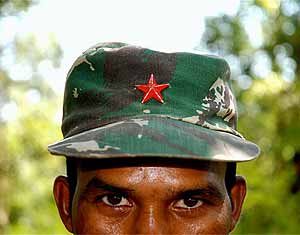24.05.2008
May 22, 2008 (the date of publication in Russian)
Alexei Chichkin
CLASS STRUGGLE IN A CASTE SOCIETY
20,000 rebellious peasants pose a threat to India's security
 During last years, the relations between the United States and India have significantly improved, and experts of both countries are discussing a strategic alliance of "two greatest world's democracies". John McCain, candidate for US Presidency from the Republican Party, insists that India be admitted to G-8 instead of Russia. To his opinion, India has reached the level of development of democratic institutions, corresponding with G-8 standards.
During last years, the relations between the United States and India have significantly improved, and experts of both countries are discussing a strategic alliance of "two greatest world's democracies". John McCain, candidate for US Presidency from the Republican Party, insists that India be admitted to G-8 instead of Russia. To his opinion, India has reached the level of development of democratic institutions, corresponding with G-8 standards.
Implementation of McCain's proposal may have ambiguous implications. In fact, there is no more country in the world with such a huge number of undernourished and illiterate people as India. On the one hand, with India the G-8 will no longer be viewed as an "alliance of fat cats", which is definitely an advantage for its image. On the other hand, the poverty of Indians is going to exacerbate due to the global food crisis, forecasted by a number of informed experts. As soon as massive famine strikes the subcontinent, other G-8 members will have to charge themselves with the problems of the most overpopulated country of the globe.
Social stratification, reaching fantastic proportions in India, is based upon the caste system of the society, inherited from the era of slavery. It makes the current political situation in India very unstable. The Russian audience is aware of clashes between India's government troops and separatist insurgents in Kashmir, Punjab, Assam, Nagaland and other provinces. However, Russian media overlook one more conflict in India that lasts for over thirty years – the confrontation between peasant guerillas and private armies of Indian landowners that enjoy support from the federal army and police.
Today, the number of rebellious peasants, active in various states of India, exceeds 20,000. Driven into despair with poverty and hunger, these representatives of lower castes unify under leftist radical banners. The guerilla movement, inspired in 1970s from China, is experiencing its second birth in the beginning of the XXI century.
In 2003, the Maoist Communist Center and the Revolutionary Communist (Maoist) Center of India issued a joint declaration, informing the working class of India of their unification. The document stated that the unified organization "is based upon ideas of Marxism, Leninism and Maoism, and is committed for development and implementation of the New Democratic revolution".
The two organizations had a longtime record of cooperation. MCC was based mostly in Bihar, Jharkhand and West Bengal, while RCCI (M) was most active in Punjab, in the former Portuguese territories (Goa, Diu, and Daman), and in the Indian part of Jammu and Kashmir.
The unified Maoist Revolutionary Communist Center of India participates in the Revolutionary Internationalist Movement that unifies over thirty leftist organizations across the globe. In 2006, Prime Minister Manmohan Singh claimed that Maoist rebels "pose a most serious threat to India's national security".
It is noteworthy that the underground peasant movement is most spread in those Indian states where social problems have never been solved since the declaration of India's independence. In particular, Bihar is dominated with classical feudalism. Local rebels fight against both regular military forces and private troops of barons. They attack training centers of local police, administrative buildings, as well as penitentiaries where their associates are confined in medieval conditions. The Maoist peasants oppose the caste system. In regions they take under control, they declare confiscation of feudal lands in favor of local peasants. The Indian guerilla movement is very similar to the Revolutionary Armed Forces of Colombia (FARC).
At the face of the unfolding food crisis, the United States expresses profound concern over the prospect of transformation of local armed clashes into a full-scale civil war. In 2006, Washington proposed assistance to the powers of Chhattisgarh state in anti-guerilla operations. US specialists were going to help to clear minefields and to instruct police in tactics of elimination of militant groups.
When this unofficial agreement surfaced in mass media, White House's spokesmen did not confirm it, indicating that "the United States coordinates all of it initiatives with the Federal Government of India". Since that episode, US and Indian authorities have been keeping their cooperation in secrecy. Judging upon indirect clues, this unofficial cooperation is likely to intensify in the nearest time.
Number of shows: 1120
 ENG
ENG 

 ENG
ENG 
